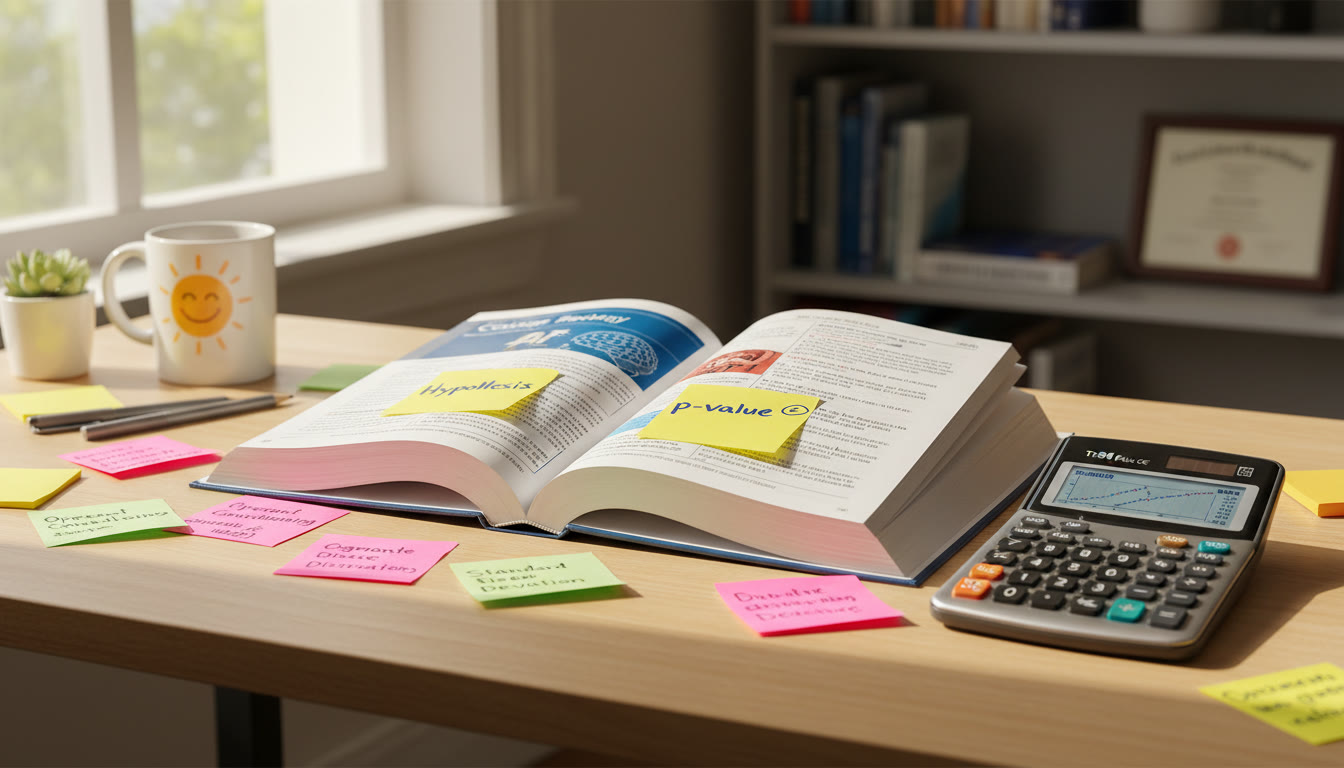Why AP Psychology and AP Statistics Matter for Pre‑Med and Neuroscience Paths
If you’re aiming for med school, a neuroscience major, or simply want a stronger application to top colleges, AP Psychology and AP Statistics aren’t just “nice to have” on your transcript — they’re strategic. Psychology gives you a formal introduction to behavior, cognition, mental health, and brain‑behavior relationships, while Statistics arms you with the quantitative reasoning used in research, evidence‑based medicine, and clinical decision making. Together they create a bridge between human science and the math that makes modern research reliable.

Big Picture: How Colleges and Med Schools View These APs
Admissions teams look for intellectual curiosity, rigor, and evidence of preparedness for college‑level thinking. AP Psychology shows you can handle biological concepts, scientific reasoning, and written argumentation about human behavior. AP Statistics signals comfort with data interpretation — a skill that’s increasingly central to medicine and neuroscience. Together, strong scores and clear narratives on applications tell admissions officers: this student can think critically about people and numbers.
What the Courses Actually Teach (and Why That Helps You)
Knowing the course map helps you study smarter. Below is a compact snapshot of the units you’ll encounter and the skills you’ll build that matter for pre‑med/neuro aspirations.
| Course | Key Units or Themes | How It Helps Pre‑Med / Neuro |
|---|---|---|
| AP Psychology | Biological bases, cognition, development, social psychology, mental health | Foundational brain science, disorders, research literacy, clinical perspectives |
| AP Statistics | Data exploration, study design, probability, sampling distributions, inference | Interpreting studies, designing experiments, understanding p‑values and confidence |
Two Contrasting Strengths You Want to Build
- Qualitative and conceptual understanding (AP Psych): learning theories, patient‑centered thinking, and historical context of psychology.
- Quantitative and methodological skills (AP Stats): reading data correctly, spotting design flaws, converting results into clinical insight.
Study Strategy: From Syllabus to Score
Moving from a syllabus to an AP score that opens doors is about quality, not just hours. Below is a semester‑to‑exam approach that balances content, practice, and real learning.
Phase 1 — Build Foundation (First 2–3 Months)
- Read the Course and Exam Description so you understand unit weightings and science practices. Use the unit breakdown to prioritize study time.
- Create a concise content map — one page per unit for Psych (key terms, major studies, neurotransmitters, disorders); one page per major topic for Stats (definitions, formulas, when to use which test).
- Begin spaced repetition for vocabulary and formulas. Flashcards for neurotransmitters, research methods, and statistical terms are gold.
Phase 2 — Skill Deepening (Middle of Year)
- AP Psychology: Practice applying theories to scenarios — it’s rare to be asked only for definitions on the exam. Write short practice responses that connect a concept to an everyday example.
- AP Statistics: Focus on interpretation rather than computation alone. Can you explain what a confidence interval means in plain English? Can you spot when a study’s sample is biased?
- Start timed practice sections. Learn pacing — you don’t want to finish questions feeling rushed or, worse, misreading data under pressure.
Phase 3 — Exam Sharpening (Last 6–8 Weeks)
- Switch to full practice tests under timed conditions. For Stats, include calculator practice with real data sets and regression output interpretation.
- Review commonly tested experiments and classic studies in Psychology — what was their method, result, and limitation? Many free‑response prompts ask you to evaluate experimental design.
- Analyze your errors. A practice test is only useful if you turn mistakes into lessons: track recurring weaknesses and target them deliberately.
Exam Mechanics and What To Focus On
Understand how points are distributed so you can prioritize during study.
| Exam | Format | Skills to Prioritize |
|---|---|---|
| AP Psychology | Multiple choice + free response; focus on concept application and research evaluation | Identify study types, apply psychological perspectives, interpret findings |
| AP Statistics | Multiple choice + free response; calculator permitted for many sections | Data analysis, probability reasoning, choosing correct inference procedures |
Practical Tips for Exam Day
- Bring an approved calculator for Stats and know how to use its stats functions. Practice the exact steps you’ll use on test day.
- For free‑response questions, outline answers quickly: claim, evidence, explanation. For Psych, tie examples to a named theory or study when relevant.
- Manage time: answer every multiple choice question (educated guesses can earn points). Allocate remaining time to fully developed free responses.
Connecting AP Content to Real Clinical and Research Thinking
Admissions committees and future clinicians don’t just want checkboxes — they want evidence that you can translate learning into practice. Here’s how to show that translation on applications, interviews, and personal statements.
Examples of Translational Thinking
- Use a Statistics project to talk about evidence evaluation: e.g., you ran a small observational study in a health class, learned about confounders, and improved your study design — that’s a narrative that shows scientific maturity.
- Use Psychology to reflect on patient perspectives: understanding attachment theory or cognitive biases can become a meaningful anecdote about empathy in patient care.
- Combine both: explain a research question that leverages a psychological theory and a statistical method (e.g., investigating stress levels across different study schedules and using appropriate inference to draw conclusions).
Study Resources That Actually Work
Not all resources are equal. Pick materials that mirror the course expectation: clear conceptual framing, real data practice, and timed exam simulations. Ideally, use College Board’s course materials as your baseline and then layer targeted practice on top.
What to Include in Your Toolkit
- AP Course and Exam Description (CED) — it tells you what’s tested and how it’s weighted.
- AP Classroom and practice questions for authentic exam style practice.
- One or two high‑quality review books and a bank of practice FRQs. Don’t collect every book — master a few well.
- Real dataset practice for Stats — analyze, interpret, and write brief conclusions as if you were reporting to a clinician.
Daily Habits That Make a Big Difference
Small, consistent actions compound. For busy students balancing labs, clubs, and volunteer hours, these habits are manageable and effective.
- Micro‑study: 25 minutes of focused study for a concept, then a 5‑minute reflection to paraphrase what you learned.
- Active recall twice per week: quiz yourself without notes on core concepts or formulas.
- Peer teaching: explain a tricky study design or a statistic to a friend — teaching is a powerful test of understanding.
- Practice academic writing: concise explanations of methods and conclusions will help on free‑response sections and in college essays.
Common Pitfalls — And How to Avoid Them
Students often trip over similar stumbling blocks. Here’s how to sidestep them.
Pitfall 1: Memorization Without Understanding
Memorizing neurotransmitter names or test formulas is necessary but not sufficient. Always ask: how would I apply this? For example, knowing that serotonin is linked to mood is useful — applying that knowledge to interpret a study on antidepressants is what earns higher scores.
Pitfall 2: Ignoring Study Design and Bias
A poorly designed study can’t be saved by beautiful statistics. For Stats and Psych, practice identifying bias, limits of generalizability, and appropriate sampling. When you see flawed methods, describe improvements — that’s the language of scientists.
Pitfall 3: Pacing Problems on Exam Day
Timed practice is the cure. Simulate the exam environment: timed sections, minimal interruptions, and the exact materials you’ll use. Develop a simple time checkpoint plan (e.g., after 30 minutes you should be X% through the multiple choice).
How to Frame These APs on Your Application
Beyond scores, tell a coherent story. Colleges value context: why you chose the course, what you learned, and how it connects to your future goals.
Writing Tips for Essays and Activity Descriptions
- Be specific: cite a particular project, experiment, or insight that shifted your thinking.
- Show growth: did Statistics make you more skeptical of sensational headlines? Did Psychology help you communicate with patients during volunteering?
- Link to future work: if you plan to pursue neuroscience or clinical research, explain how these courses gave you a running start.
How Personalized Tutoring Can Accelerate Your Path — Naturally
Many successful students combine classroom learning with targeted support. Personalized tutoring can make the difference between knowing content and mastering exam‑grade application. When done well, it’s not about cramming; it’s about accelerating habits that last into college and beyond.
Sparkl’s personalized tutoring model — 1‑on‑1 guidance, tailored study plans, expert tutors with subject knowledge, and AI‑driven insights to pinpoint weak spots — can be particularly helpful when you need to translate AP concepts into research questions or narrative evidence for applications. A tutor who understands both AP expectations and the language of pre‑med or neuroscience can help you design projects, practice FRQs, and craft application stories that highlight substance, not just scores.
Sample 12‑Week Sprint (Last Term Before Exam)
Here’s a compact, actionable plan you can adapt to your schedule. It balances content, practice, and reflection.
| Week | Focus (Psych) | Focus (Stats) | Practice Goal |
|---|---|---|---|
| 1–2 | Biological bases review; key studies | Data description; graphs; calculators | Create one‑page unit summaries |
| 3–4 | Cognition and development applied scenarios | Sampling, study design, bias detection | Timed MCQ sets; 2 FRQs |
| 5–6 | Mental health and treatments; diagnostic criteria practice | Probability and distributions | Full practice section; error analysis |
| 7–8 | Social psychology and personality applications | Inference basics and confidence intervals | Full practice exam; targeted review |
| 9–10 | Review weakest Psych units; practice FRQ rubrics | Regression and interpreting output; simulation practice | Two timed full exams |
| 11–12 | Light content review; test strategy; rest and pacing | Final problem sets; quick formula check | One final full exam; relaxation protocol |
Real‑World Examples and Mini‑Projects
Mini‑research projects look great on applications and deepen understanding. Here are two ideas you can do with classroom resources or simple volunteer settings.
Mini‑Project 1: Observational Study on Sleep and Memory
- Design a small survey among classmates about sleep hours and a short memory quiz.
- Use descriptive statistics and a basic inference test to evaluate the relationship.
- Write a 1‑page report that discusses limitations, possible confounders, and follow‑up experiments.
Mini‑Project 2: Intervention Reflection — Cognitive Strategies for Stress
- Coordinate a short workshop teaching one stress‑management technique (e.g., breathing or cognitive reframing).
- Measure self‑reported stress before and after using a small, anonymous scale and describe the results statistically.
- Connect findings to psychological theory and reflect on ethical considerations and measurement limits.
Parents’ Corner: How to Support Without Micromanaging
Parents, your encouragement matters. The most helpful things you can do are structure, emotional support, and resources — not quizzes or nagging.
- Help create a predictable study schedule and quiet environment.
- Encourage realistic rest and exercise, which directly affect learning and memory.
- Consider investing in targeted help (like Sparkl’s tutoring) if a student struggles with foundational gaps or needs focused strategy coaching.
Final Thoughts: Beyond the Exam
AP Psychology and AP Statistics are more than a path to credit or a test score. They’re training in scientific thinking, empathy, and the language of evidence — exactly the skills a future clinician or neuroscientist needs. Whether you pursue research, patient care, or both, these courses give you an early map of how to ask good questions, design fair studies, and interpret data with humility.
Do the work thoughtfully, use practice tests to inform smart studying, and seek help where you need it. A tutor who understands both AP expectations and the pre‑med/neuroscience pathway can accelerate that growth by personalizing your plan, clarifying tricky concepts, and turning practice tests into learning gold. When Sparkl’s tutors guide students one‑on‑one, they often report faster gains because the feedback is immediate and tailored — exactly what matters in a high‑stakes, concept‑driven sequence like AP Psych and AP Stats.
Go Forward with Purpose
Take ownership of your learning, aim for depth over breadth, and tell a clear story about how these courses fit into your future. With disciplined practice, thoughtful projects, and targeted support where you need it, AP Psychology and AP Statistics can become powerful proof points on your path to top colleges and, eventually, a career in medicine or neuroscience.

Good luck — and remember: curiosity plus careful practice is the winning formula. If you want, we can build a tailored 12‑week plan together that maps to your schedule, strengths, and college goals.





















No Comments
Leave a comment Cancel